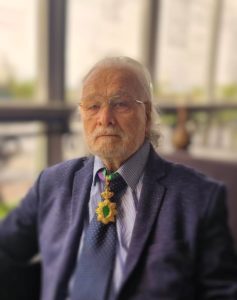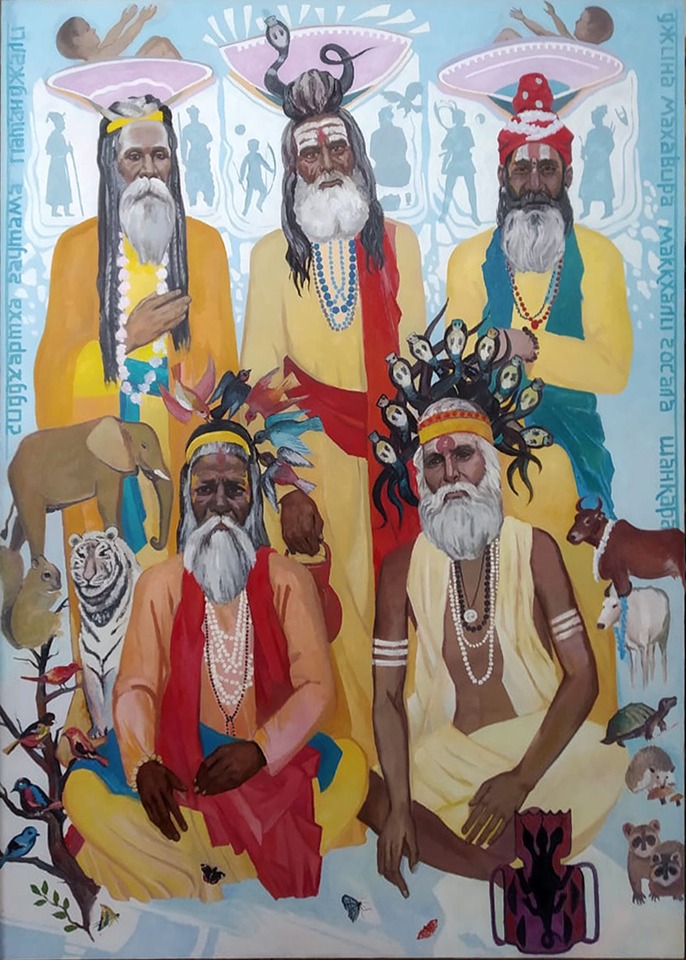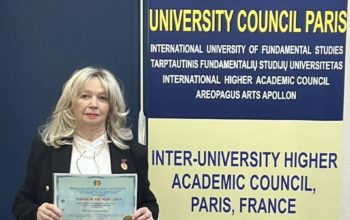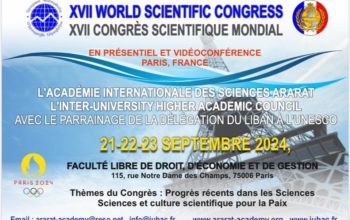
Prof. Anatoly Silov, Grand Doctor, Academician
Today, the World Scientists Journal has the honor of interviewing the renowned artist Prof. Silov Anatoly Alexandrovich. Prof. Silov, President of Art Academy , Head of the Department of paintings IUFS (International University of Fundamental Studies), a People’s Artist of the Chuvash Republic and an esteemed member of the Academy of Arts of Tajikistan, has dedicated his life to capturing the essence of world civilizations through his art. His extensive portfolio boasts over 400 large-format paintings, depicting the portraits of kings, philosophers, and prominent figures from ancient and modern China, India, the Middle East, Europe, and Russia. Each piece is rendered with meticulous historical accuracy and a deep respect for the subjects, reflecting his profound understanding of global cultures. Prof. Silov’s work also includes a significant series on the World Nations, highlighting the evolving geopolitical landscape. Today, we delve into the creative mind behind these masterpieces and explore the inspirations and experiences that have shaped his illustrious career.
World Scientists Journal (WSJ): Prof. Silov, it’s an honor to have you with us today. To begin, could you share with us some details about your early life and the significant influences that shaped your career as an artist?
Prof. Silov Anatoly Alexandrovich: I was born on May 20, 1938, in the Chuvash Republic, Cheboksary. My journey as an artist began at an early age, deeply influenced by the rich cultural heritage of my homeland. Over the years, I have pursued my passion for art, focusing on themes of world civilizations, their origin, development, and decline, as well as the notable personalities who have left their mark on history.
WSJ: You have been recognized as a People’s Artist of the Chuvash Republic and a full member of the Academy of Arts of Tajikistan. Could you tell us more about these honors and how they have impacted your career?
Prof. Silov: Being recognized as a People’s Artist of the Chuvash Republic and a full member of the Academy of Arts of Tajikistan are tremendous honors. These accolades validate my lifelong dedication to the arts and have opened many doors for me, allowing me to collaborate with fellow artists and participate in significant cultural exchanges. They have also inspired me to continue my work with renewed vigor and commitment.
WSJ: Your work as a painter spans several decades and includes over 400 works on world processes and notable personalities. Can you elaborate on the themes and styles that dominate your paintings?
Prof. Silov: My dominant theme revolves around world civilizations—exploring their origins, development, and decline. I focus on portraying outstanding personalities from different eras and cultures, including founders of states, major philosophers, and scientists. My works are large-format paintings created in a realistic manner, ensuring historical accuracy. I have also created a separate series dedicated to the main religions of the world, emphasizing the interconnectedness of human history and culture.
WSJ: You’ve mentioned your participation in exhibitions dedicated to BRICS summits and your ongoing work on paintings related to BRICS. What motivates you to focus on this theme, and what do you hope to convey through these works?
Prof. Silov: The BRICS theme is particularly inspiring because it represents the collaboration and unity of emerging economies and cultures. I have created five large paintings on this theme and am currently working on six more, depicting the presidents of the newly admitted World Countries. Through these works, I aim to highlight the significance of international cooperation and the potential for these nations to shape a better future. My hope is that these paintings will inspire continued collaboration and mutual understanding among BRICS countries.
WSJ: As a professor at the IUHAC in Paris and the head of the department of fine arts, how do you balance your teaching responsibilities with your artistic endeavors?
Prof. Silov: Balancing teaching and my artistic work is indeed a challenge, but it is also incredibly rewarding. Teaching allows me to share my knowledge and passion for art with the next generation of artists, while my own artistic endeavors provide me with continuous inspiration and new ideas to bring into the classroom. It’s a symbiotic relationship that keeps me engaged and motivated in both areas.
WSJ: Your career has seen a diverse range of artistic expressions, from painting to designing medals and orders. Can you tell us about your work in designing awards for events such as the World summit and the Olympics?
Prof. Silov: Designing medals and orders has been an exciting extension of my artistic practice. I’ve created more than 92 sketches for various prestigious events, including the Olympics 2024, and for heads of state and public organizations. This work requires a deep understanding of symbolism and the ability to convey significant achievements and values through visual art. It’s a fulfilling way to contribute to important global events and to honor remarkable individuals and their contributions.
WSJ: You’ve mentioned the concept of a Museum of World Civilizations. Can you expand on this idea and your vision for such an institution?
Prof. Silov: The idea of a Museum of World Civilizations is a dream project of mine. I envision it as a space that celebrates the rich tapestry of human history and cultural achievements from around the world. Kazan, with its historical and cultural significance, would be an ideal location for such a museum. Over time, I believe this museum could become a central hub for world art, fostering a deeper understanding and appreciation of global civilizations. I have already completed several preliminary sketches for this project, and I hope to see it come to fruition in the near future.
WSJ: Your extensive body of work includes not only paintings but also sketches for tapestries and medals. How do you approach the process of creating such diverse forms of art?
Prof. Silov: My approach to creating diverse forms of art involves a deep commitment to research and historical accuracy. Whether I am working on a painting, tapestry, or medal, I immerse myself in the subject matter, studying historical documents, artifacts, and other sources of information. This ensures that my work not only captures the aesthetic qualities of the subject but also its historical and cultural significance. Each project is an opportunity to explore new techniques and mediums, which keeps my creative process dynamic and fulfilling.
WSJ: Could you tell us more about your series of paintings dedicated to the main religions of the world? What inspired you to create this series, and what message do you hope to convey?
Prof. Silov: The series dedicated to the main religions of the world was inspired by my belief in the importance of understanding and respecting different cultural and religious traditions. Through these paintings, I aim to highlight the common values and spiritual teachings that unite humanity, despite our diverse beliefs and practices. Each painting in the series is a tribute to the rich heritage and profound wisdom of the world’s major religions, and I hope they inspire viewers to seek deeper understanding and harmony.
WSJ: Your work often explores the themes of world civilizations and notable historical figures. How do you decide which figures or events to depict in your art?
Prof. Silov: When deciding which figures or events to depict, I look for individuals and moments that have had a significant impact on the course of history and culture. I am particularly drawn to those who have made lasting contributions to their societies and to humanity as a whole. My goal is to celebrate their achievements and to provide a visual narrative that connects the past with the present. I also consider the educational value of my work, aiming to create pieces that not only captivate the viewer but also inform and inspire.
WSJ: In your opinion, what role does art play in fostering international understanding and cooperation?
Prof. Silov: Art has a unique ability to transcend linguistic and cultural barriers, making it a powerful tool for fostering international understanding and cooperation. Through art, we can share our stories, values, and experiences in a way that resonates on a universal level. It allows us to see the world through each other’s eyes and to appreciate our common humanity. By highlighting the beauty and diversity of different cultures, art can build bridges and promote a sense of global community.
WSJ: As a self-made artist who has achieved significant success, what challenges did you face along the way, and how did you overcome them?
Prof. Silov: The journey of a self-made artist is filled with challenges, from financial constraints to finding opportunities to showcase one’s work. I faced many obstacles, including limited resources and the need to constantly prove myself. However, my passion for art and my determination to succeed kept me going. I worked tirelessly to improve my skills, sought out mentors and collaborators, and remained open to new opportunities. Perseverance, resilience, and a deep love for what I do have been the keys to overcoming these challenges.
WSJ: what advice would you give to young artists who aspire to make a significant impact in the world of art?
Prof. Silov: My advice to young artists is to remain true to their vision and never stop honing their craft. Art is a powerful medium that can influence and inspire, but it requires dedication, hard work, and resilience. Embrace your unique perspective and experiences, and use them to create work that resonates with others. Remember, talent is only a gift from God when you do not stop working on yourself and continuously strive for excellence. Stay curious, stay passionate, and never be afraid to take risks and explore new ideas.
WSJ: Finally, Dr. Silov, your artworks are incredibly captivating and historically rich. If someone is interested in purchasing your paintings, is that possible? How can they place an order, and what is the best way to contact you for such inquiries?
Prof. Silov: I appreciate your interest in my work. Yes, my paintings are available for purchase. Each piece is unique and carries a part of the extensive history and culture that I strive to portray. Those interested in acquiring my artwork can contact me directly to discuss the details. I am available for inquiries via email info@iuhac.fr or email. anatoly@silov.ru through my official website Iuhac.fr where you can view my portfolio and find more information about my works. Additionally, I am represented by several galleries, and potential buyers can also reach out to these institutions to explore available pieces and make arrangements for purchase.
Article written and Interview By Prof. J.S.K.Jayasekara
World Scientists Journal (WSJ)



